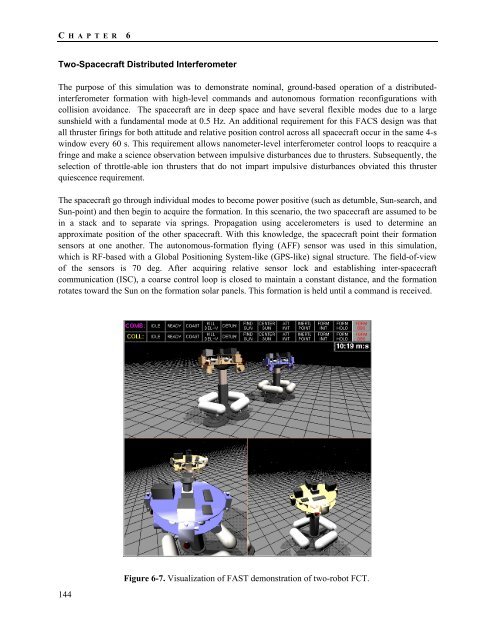TPF-I SWG Report - Exoplanet Exploration Program - NASA
TPF-I SWG Report - Exoplanet Exploration Program - NASA
TPF-I SWG Report - Exoplanet Exploration Program - NASA
You also want an ePaper? Increase the reach of your titles
YUMPU automatically turns print PDFs into web optimized ePapers that Google loves.
C HAPTER 6<br />
Two-Spacecraft Distributed Interferometer<br />
The purpose of this simulation was to demonstrate nominal, ground-based operation of a distributedinterferometer<br />
formation with high-level commands and autonomous formation reconfigurations with<br />
collision avoidance. The spacecraft are in deep space and have several flexible modes due to a large<br />
sunshield with a fundamental mode at 0.5 Hz. An additional requirement for this FACS design was that<br />
all thruster firings for both attitude and relative position control across all spacecraft occur in the same 4-s<br />
window every 60 s. This requirement allows nanometer-level interferometer control loops to reacquire a<br />
fringe and make a science observation between impulsive disturbances due to thrusters. Subsequently, the<br />
selection of throttle-able ion thrusters that do not impart impulsive disturbances obviated this thruster<br />
quiescence requirement.<br />
The spacecraft go through individual modes to become power positive (such as detumble, Sun-search, and<br />
Sun-point) and then begin to acquire the formation. In this scenario, the two spacecraft are assumed to be<br />
in a stack and to separate via springs. Propagation using accelerometers is used to determine an<br />
approximate position of the other spacecraft. With this knowledge, the spacecraft point their formation<br />
sensors at one another. The autonomous-formation flying (AFF) sensor was used in this simulation,<br />
which is RF-based with a Global Positioning System-like (GPS-like) signal structure. The field-of-view<br />
of the sensors is 70 deg. After acquiring relative sensor lock and establishing inter-spacecraft<br />
communication (ISC), a coarse control loop is closed to maintain a constant distance, and the formation<br />
rotates toward the Sun on the formation solar panels. This formation is held until a command is received.<br />
144<br />
Figure 6-7. Visualization of FAST demonstration of two-robot FCT.
















